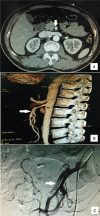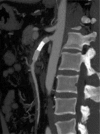Endovascular stenting of spontaneous isolated dissection of the superior mesenteric artery: A case report and literature review
- PMID: 29145276
- PMCID: PMC5704821
- DOI: 10.1097/MD.0000000000008598
Endovascular stenting of spontaneous isolated dissection of the superior mesenteric artery: A case report and literature review
Abstract
Rationale: Spontaneous isolated dissection of the superior mesenteric artery (SID-SMA) is a rare arterial disease that is difficult to differentiate from other diseases because of lack of specific clinical manifestation and for which there is no available optimal management strategy.
Patient concerns: A 58-year-old male patient visited our emergency room with sudden onset of moderate-severe epigastric abdominal pain of uncertain cause.
Diagnoses: Computed tomography scanning showed a characteristic "double lumen sign" of the superior mesenteric artery, and further computed tomography angiography findings revealed a dissected segment of the superior mesenteric artery.
Interventions: Conservative management was administered for 5 days, but the abdominal pain remained. Subsequently, an endovascular stent was placed in the affected superior mesenteric artery. Postoperative antiplatelet therapy was administered for 6 months.
Outcomes: The abdominal pain was relieved. Six months later, a follow-up of computed tomography angiography showed that the stent placed had no interval narrowing.
Lessons: Based on our review and the illustration of this case, endovascular stenting may be a preferred rescue treatment in SID-SMA patients for whom initial conservative treatment fails.
Conflict of interest statement
The authors declare no conflicts of interest.
Figures



Similar articles
-
Value of endovascular stent placement for symptomatic spontaneous isolated superior mesenteric artery dissection.Eur J Radiol. 2013 Mar;82(3):490-6. doi: 10.1016/j.ejrad.2012.09.005. Epub 2012 Oct 23. Eur J Radiol. 2013. PMID: 23092539
-
Retrograde Stent Placement for Symptomatic Spontaneous Isolated Dissection of the Superior Mesenteric Artery.Ann Vasc Surg. 2016 Aug;35:203.e17-21. doi: 10.1016/j.avsg.2016.01.029. Epub 2016 May 26. Ann Vasc Surg. 2016. PMID: 27236096
-
Current strategy for the treatment of symptomatic spontaneous isolated dissection of superior mesenteric artery.J Vasc Surg. 2011 Aug;54(2):461-6. doi: 10.1016/j.jvs.2011.03.001. Epub 2011 May 14. J Vasc Surg. 2011. PMID: 21571493
-
Endovascular management for isolated spontaneous dissection of the superior mesenteric artery: report of two cases and literature review.J Vasc Interv Radiol. 2011 Aug;22(8):1206-11. doi: 10.1016/j.jvir.2011.01.446. J Vasc Interv Radiol. 2011. PMID: 21801996 Review.
-
Endovascular treatment of spontaneous dissections of the superior mesenteric artery.J Vasc Surg. 2009 Dec;50(6):1326-32. doi: 10.1016/j.jvs.2009.07.019. Epub 2009 Sep 26. J Vasc Surg. 2009. PMID: 19782510 Review.
Cited by
-
Small intestinal autotransplantation for spontaneous isolated superior mesenteric artery dissection: A case report.Medicine (Baltimore). 2019 Nov;98(47):e17837. doi: 10.1097/MD.0000000000017837. Medicine (Baltimore). 2019. PMID: 31764779 Free PMC article.
-
Diagnosis and Management of Isolated Superior Mesenteric Artery Dissection: A Systematic Review and Meta-Analysis.Korean Circ J. 2019 May;49(5):400-418. doi: 10.4070/kcj.2018.0429. Korean Circ J. 2019. PMID: 31074212 Free PMC article. Review.
-
Combination treatment for superior mesenteric artery dissection: therapeutic challenge.J Vasc Bras. 2022 Mar 7;21:e20210157. doi: 10.1590/1677-5449.210157. eCollection 2022. J Vasc Bras. 2022. PMID: 35399343 Free PMC article.
References
-
- Kim HK, Jung HK, Cho J, et al. Clinical and radiologic course of symptomatic spontaneous isolated dissection of the superior mesenteric artery treated with conservative management. J Vasc Surg 2014;59:465–72. - PubMed
-
- Cho YP, Ko GY, Kim HK, et al. Conservative management of symptomatic spontaneous isolated dissection of the superior mesenteric artery. Br J Surg 2009;96:720–3. - PubMed
-
- Heo SH, Kim YW, Woo SY, et al. Treatment strategy based on the natural course for patients with spontaneous isolated superior mesenteric artery dissection. J Vasc Surg 2017;65:1142–51. - PubMed
Publication types
MeSH terms
LinkOut - more resources
Full Text Sources
Other Literature Sources

